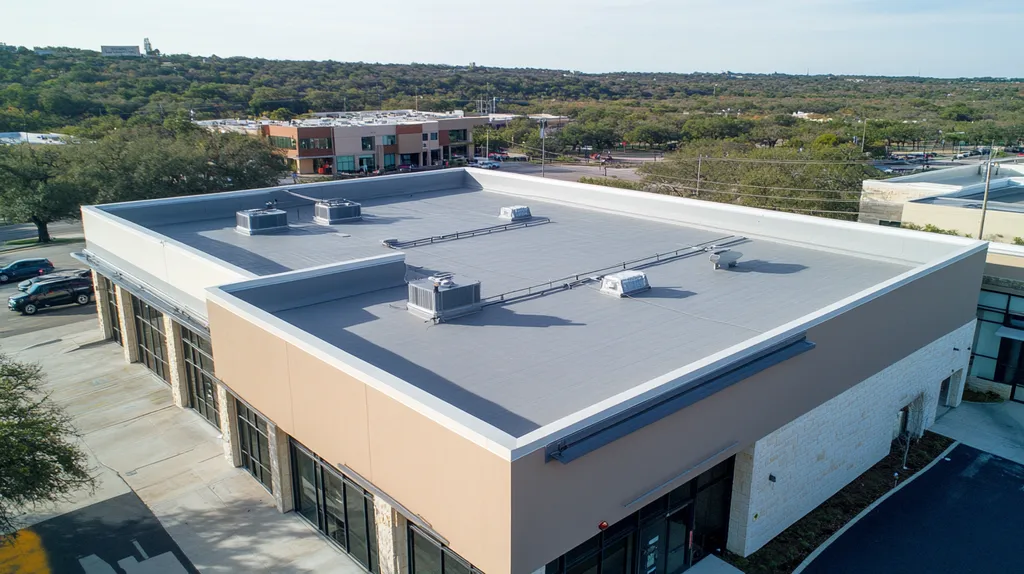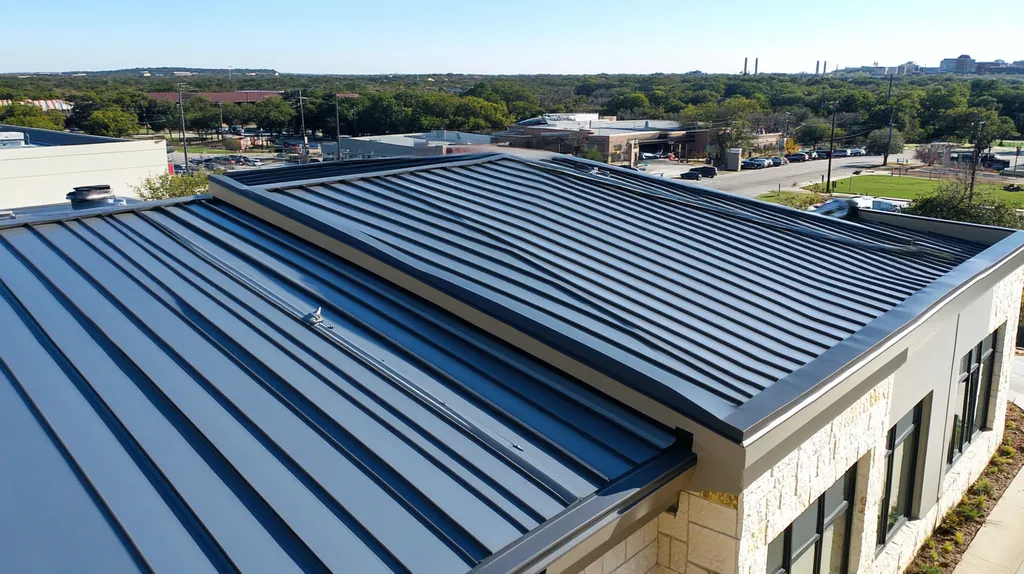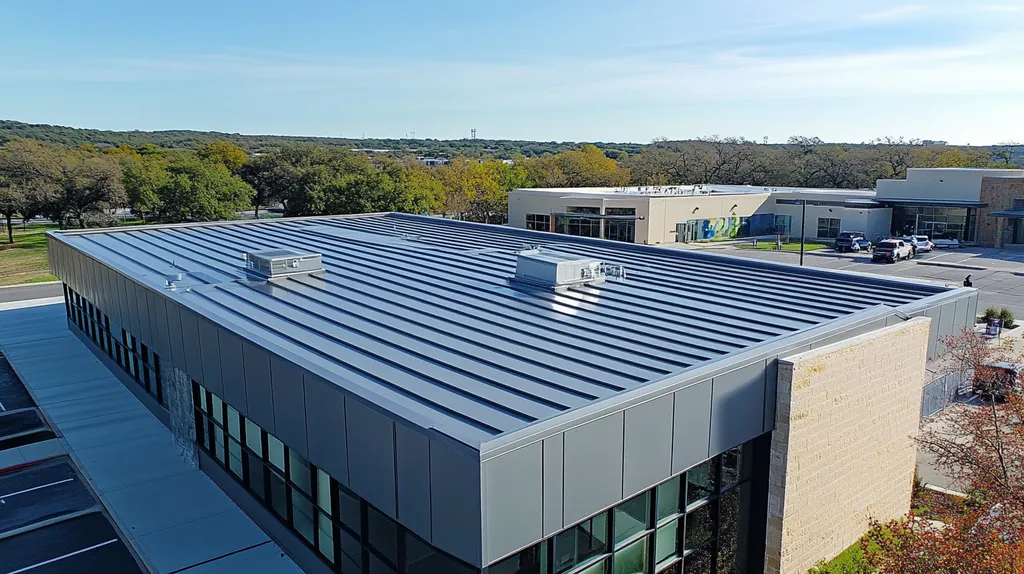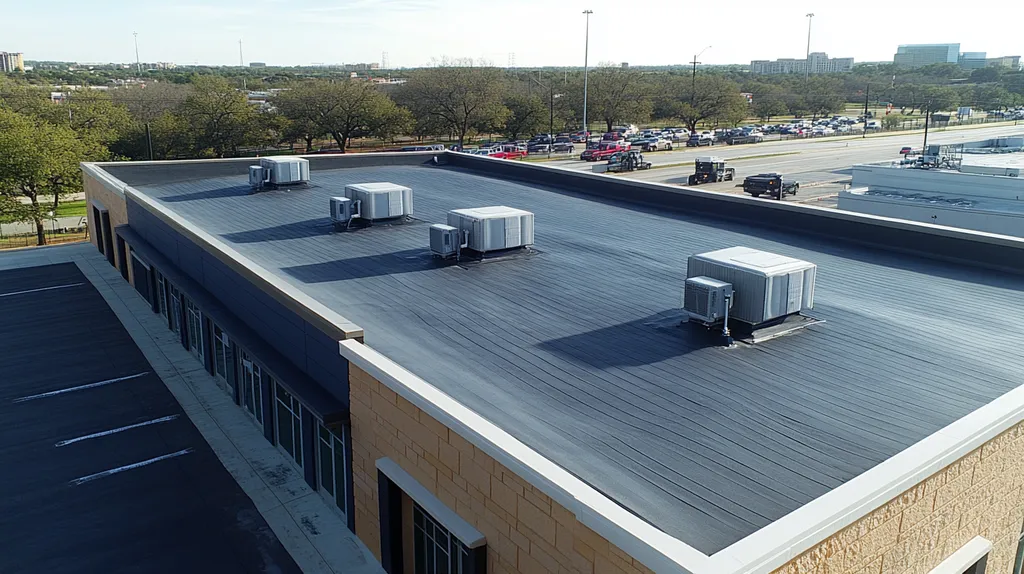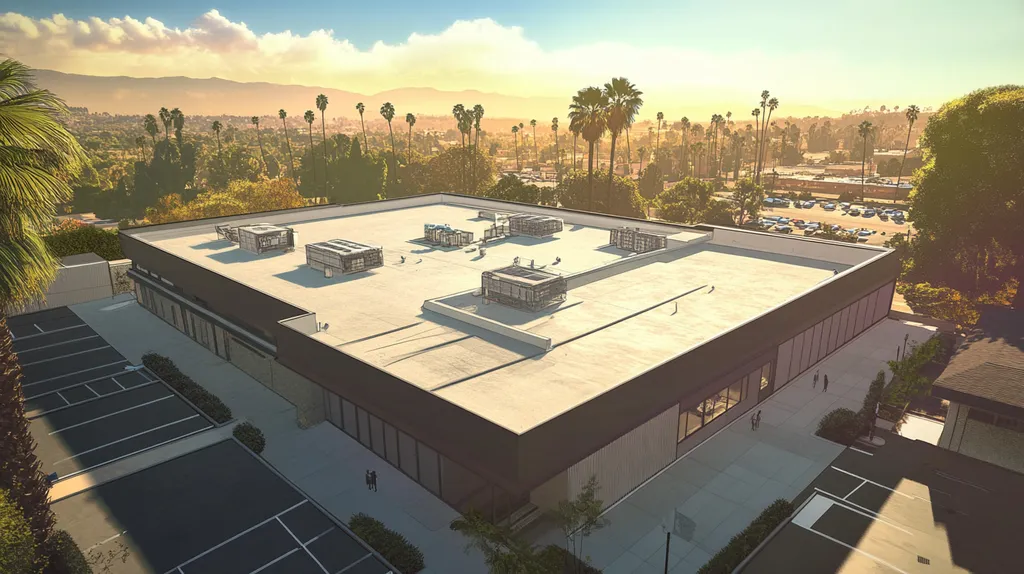Welcome to today’s Battle Royale featuring two roofing heavyweights: “Modified Bitumen” in the east corner versus “Flame Retardant Coatings” in the west!
Tonight’s showdown pits these contenders against each other across six punishing rounds designed to test every aspect of their performance for Fire Ratings for Commercial Roof Projects.
At stake? Millions in potential costs, decades of building protection, and the critical performance demands of modern commercial and industrial facilities.
Our professional judging panel will evaluate each round on technical merit, real-world performance, and value delivery. After all six rounds, we’ll declare our ultimate champion.
Ladies and gentlemen, facility managers and building owners… it’s time to rumble!
ROUND 1: INITIAL COSTS & INSTALLATION
When evaluating commercial roofing systems, fire safety can literally mean the difference between business continuity and catastrophic loss. The stakes become even higher when considering that fire-related property damage in commercial buildings exceeded $3.2 billion last year. For facility managers and property owners, understanding the cost implications and installation requirements of Modified Bitumen versus Flame Retardant Coatings is crucial for making informed decisions that balance safety with budget constraints.
Material Expenses
Class A fire-rated roofing assemblies must withstand temperatures up to 1400°F with a maximum flame spread of 6 feet, significantly impacting material selection and costs. The incorporation of noncombustible elements like gypsum roof boards often proves essential for achieving these ratings. (source: National Gypsum Company)
Modified Bitumen systems typically range from $3.50 to $7.00 per square foot, including necessary fire-resistant underlayments and cover boards. This comprehensive system offers an economical approach while meeting fire safety requirements.
Flame Retardant Coatings generally cost more, ranging from $5.00 to $12.00 per square foot for complete coverage. While the initial investment is higher, these coatings can be applied to various substrates, potentially reducing the need for additional fire-resistant layers.
For material expenses, Modified Bitumen demonstrates a clear advantage due to its lower overall system costs while maintaining required fire ratings.
Installation Complexity
The complexity of installation directly impacts both project timelines and labor costs. Modified Bitumen installation follows well-established procedures that most commercial roofing crews can execute efficiently.
Modified Bitumen systems require careful attention to seam integrity and proper torch application, but these techniques are standardized across the industry. Most crews can complete installation without specialized training beyond standard certifications.
Flame Retardant Coatings demand more precise application conditions and specialized equipment. Proper thickness, coverage, and curing time must be carefully monitored to ensure effective fire protection.
In terms of installation complexity, Modified Bitumen holds the advantage due to its more straightforward application process and wider availability of qualified installers.
Project Timeline
Project duration significantly impacts business operations and overall costs. Modified Bitumen installations typically require 5-7 working days for an average commercial roof, with weather being the primary variable.
The sequential nature of Modified Bitumen installation allows for efficient project management and predictable completion schedules. Crews can often work on different sections simultaneously, accelerating the overall timeline.
Flame Retardant Coatings require specific environmental conditions and multiple coating layers, each needing proper curing time. This process can extend project timelines to 10-14 days or longer, depending on weather conditions.
Regarding project timeline, Modified Bitumen demonstrates another clear advantage with its more efficient installation process and shorter completion time.
ROUND 1 WINNER: MODIFIED BITUMEN
ROUND 2: DURABILITY & LIFESPAN
When evaluating commercial roofing systems, durability and lifespan directly impact both fire safety compliance and bottom-line costs. With commercial roof maintenance accounting for up to 30% of building upkeep expenses, the choice between Modified Bitumen and Flame Retardant Coatings becomes increasingly critical.
Understanding how these systems perform under real-world conditions, including extreme temperatures and environmental stressors, is essential for making informed decisions that protect both assets and occupants.
Weather Resistance Performance
Commercial roofs must maintain their fire-resistant properties while enduring constant exposure to UV radiation, temperature fluctuations, and precipitation. The ability to retain fire-protective characteristics under these conditions is crucial for long-term safety.
Modified Bitumen systems demonstrate excellent resistance to thermal cycling and maintain consistent performance across varying weather conditions. Their multi-layer construction helps preserve fire-resistant properties even after years of exposure.
Flame Retardant Coatings can experience degradation from UV exposure and may require periodic reapplication to maintain optimal fire protection. However, when properly maintained, they provide superior protection against temperature extremes.
In weather resistance, Modified Bitumen earns an “ADVANTAGE” due to its more stable long-term performance.
Impact and Puncture Resistance
The UL 790 evaluation requires roofing systems to maintain their fire ratings even after exposure to physical stress. This includes resistance to impacts from falling debris and maintenance foot traffic that could compromise fire protection.
Modified Bitumen’s robust construction provides excellent puncture resistance and maintains its fire-protective properties even after minor impacts. The multi-ply system creates redundancy that helps preserve fire ratings despite surface damage.
Flame Retardant Coatings offer good impact resistance but can be more susceptible to damage that might affect their fire-protective properties. Local repairs are typically simpler but must be carefully executed to maintain proper coverage.
For impact and puncture resistance, both systems demonstrate comparable performance, resulting in a “TIE.”
Maintenance Requirements
Modified Bitumen systems typically require minimal maintenance to retain their fire ratings, with annual inspections and basic repairs usually sufficient. Their proven track record in maintaining fire protection makes long-term maintenance planning straightforward.
Flame Retardant Coatings need more frequent assessment to ensure coating integrity and fire-protective properties remain intact. Regular reapplication cycles must be factored into maintenance schedules and budgets.
While both systems can achieve similar lifespans, Flame Retardant Coatings offer more flexibility in extending protection through targeted maintenance. This adaptability gives them an “ADVANTAGE” in this category.
ROUND 2 WINNER: TIE
ROUND 3: PERFORMANCE FACTORS
Fire performance in commercial roofing directly impacts business survival and insurance costs. With property losses from commercial fires reaching historic highs, choosing the right fire-rated roofing system becomes crucial. Understanding how Modified Bitumen and Flame Retardant Coatings perform under real-world conditions helps facility managers make informed decisions that protect both assets and occupants.
Fire Resistance Ratings
Fire resistance ratings determine a roof’s ability to withstand flame exposure and prevent fire spread. Many regions now require Class A fire ratings for commercial roofs, particularly in areas prone to wildfires. (source: Sheffield Metals)
Modified Bitumen systems consistently achieve Class A ratings through their multi-layer construction. The inherent properties of these materials create an effective barrier against flame spread and heat penetration.
Flame Retardant Coatings can upgrade existing roofs to Class A ratings when properly applied. However, their effectiveness depends heavily on application thickness and coverage uniformity.
For fire resistance ratings, Modified Bitumen takes the ADVANTAGE due to its more consistent and reliable performance.
Heat Resistance Performance
Commercial roofs must maintain their protective properties even under extreme heat conditions. This capability directly impacts both building safety and long-term maintenance costs.
Modified Bitumen demonstrates excellent stability under high temperatures, with minimal degradation of its fire-resistant properties. Its multi-layer construction helps distribute heat loads effectively.
Flame Retardant Coatings can experience accelerated wear when exposed to prolonged heat cycles. While effective initially, their protective properties may diminish faster than traditional systems.
Regarding heat resistance performance, Modified Bitumen earns the ADVANTAGE through superior thermal stability.
System Integration
The effectiveness of fire-rated roofing depends heavily on how well components work together. Proper integration ensures consistent protection across the entire roof surface.
Modified Bitumen systems offer proven compatibility between layers, creating a unified barrier against fire spread. Their standardized installation methods ensure reliable performance across different conditions.
Flame Retardant Coatings must be carefully matched to underlying substrates to achieve optimal protection. While versatile, they require more precise specification and application procedures.
In system integration, Modified Bitumen claims another ADVANTAGE due to its more predictable component interaction.
ROUND 3 WINNER: Modified Bitumen
ROUND 4: MAINTENANCE REQUIREMENTS
For commercial property owners, maintenance requirements can make or break a roofing system’s long-term viability and fire safety compliance. With roof maintenance consuming up to 25% of building operating budgets, choosing between Modified Bitumen and Flame Retardant Coatings requires careful consideration of ongoing care needs. Understanding these maintenance demands is crucial for protecting both safety ratings and financial investments.
Preventive Maintenance Needs
Regular preventive maintenance directly impacts a roof’s ability to maintain its fire rating and structural integrity. The frequency and complexity of these maintenance activities significantly affect both operational costs and safety compliance.
Modified Bitumen systems typically require semi-annual inspections and basic cleaning to maintain their fire-resistant properties. Their robust construction allows for straightforward maintenance procedures that most facility teams can handle with minimal specialized training.
Flame Retardant Coatings demand more frequent inspections to verify coating integrity and fire-protective properties. Regular thickness testing and surface evaluations are essential to ensure continued compliance with fire safety standards.
For preventive maintenance needs, Modified Bitumen claims an ADVANTAGE due to its more straightforward maintenance requirements.
Repair Procedures
Fire-rated roofing systems require specialized repair procedures to maintain their protective properties. The complexity and frequency of these repairs directly impact both maintenance budgets and building safety.
Modified Bitumen repairs typically involve straightforward patching techniques that preserve the system’s fire rating. Most repairs can be completed quickly without compromising the overall integrity of the fire-protective system.
Flame Retardant Coatings often require more precise repair procedures to maintain consistent coverage and fire protection. Even minor repairs must carefully match existing coating thickness and composition to maintain fire ratings.
In repair procedures, Modified Bitumen demonstrates another ADVANTAGE through its more manageable repair requirements.
Long-term Performance
A roofing system must maintain its fire-protective properties throughout its service life. Proper maintenance procedures significantly impact this long-term performance and safety compliance. (source: GAF)
Modified Bitumen systems typically maintain consistent performance with standard maintenance protocols. Their multi-layer construction helps preserve fire-resistant properties even as the system ages.
Flame Retardant Coatings may require periodic reapplication to maintain optimal fire protection. While effective when properly maintained, their performance can decline more rapidly without rigorous maintenance adherence.
Regarding long-term performance, Modified Bitumen earns the ADVANTAGE through more stable long-term characteristics.
ROUND 4 WINNER: Modified Bitumen
ROUND 5: SUSTAINABILITY CREDENTIALS
With environmental regulations tightening and energy costs soaring, sustainability has become a critical factor in commercial roofing decisions. Commercial buildings now account for nearly 35% of total energy consumption in developed nations, making roofing choices increasingly scrutinized for their environmental impact.
The intersection of fire safety and sustainability presents unique challenges for facility managers who must balance protective requirements with environmental responsibility. Understanding how different roofing systems impact both safety and sustainability helps inform decisions that protect assets while supporting corporate environmental goals.
Environmental Impact
Sustainable roofing materials must deliver both environmental benefits and reliable fire protection. Modern commercial buildings face increasing pressure to reduce their carbon footprint while maintaining strict safety standards.
Modified Bitumen systems contain petroleum-based products that can be challenging to recycle. While some manufacturers have developed partially recycled content options, the production process still carries a significant environmental impact.
Flame Retardant Coatings typically contain fewer volatile organic compounds (VOCs) and can be applied over existing materials, reducing landfill waste. Their reflective properties also help minimize urban heat island effects.
For environmental impact, Flame Retardant Coatings earn an ADVANTAGE through their lower carbon footprint and waste reduction capabilities.
Resource Conservation
The efficient use of materials and energy resources directly impacts both environmental performance and operational costs. Roofing systems must demonstrate responsible resource management throughout their lifecycle.
Modified Bitumen systems require significant energy during manufacturing and installation. Their multi-layer construction, while effective for fire protection, demands more raw materials than alternative solutions.
Flame Retardant Coatings can be precisely applied to match specific protection needs, minimizing material waste. Their ability to extend existing roof life reduces resource consumption for replacements.
In resource conservation, Flame Retardant Coatings demonstrate an ADVANTAGE through more efficient material utilization.
Energy Performance
A roofing system’s impact on building energy consumption significantly affects its overall sustainability profile. Fire-rated roofing must balance protective properties with thermal performance. (source: GAF Roofing)
Modified Bitumen systems typically absorb more solar radiation, potentially increasing cooling loads. While some variants include reflective surfaces, their base material properties limit energy performance.
Flame Retardant Coatings excel in solar reflectance and thermal emission. Their customizable application allows for optimization of both fire protection and energy efficiency.
Regarding energy performance, Flame Retardant Coatings claim another ADVANTAGE through superior thermal management capabilities.
ROUND 5 WINNER: Flame Retardant Coatings
ROUND 6: SPECIALIZED APPLICATIONS
Specialized roofing applications present unique fire safety challenges that can make or break a commercial building’s defense against catastrophic loss. With industrial fire losses exceeding $1.5 billion annually, choosing between Modified Bitumen and Flame Retardant Coatings becomes particularly critical in high-risk environments where standard solutions may fall short.
High-Risk Environments
Commercial facilities with elevated fire risks require roofing systems that exceed standard fire ratings. Chemical storage facilities, manufacturing plants, and data centers demand exceptional protection against both internal and external fire threats.
Modified Bitumen systems provide consistent Class A fire ratings through their inherent material properties. Their multi-layer construction creates reliable barriers against flame spread, particularly beneficial in facilities with regular exposure to heat or sparks.
Flame Retardant Coatings offer customizable protection levels that can be enhanced for specific risk zones. Their ability to be applied in varying thicknesses allows for targeted reinforcement of particularly vulnerable areas.
For high-risk environments, Flame Retardant Coatings earn an ADVANTAGE due to their adaptability to specific threat levels.
Process-Critical Facilities
Facilities where continuous operations are essential require roofing systems that can be installed and maintained without significant disruption. Healthcare facilities, food processing plants, and pharmaceutical manufacturers cannot afford extended shutdowns for roofing work.
Modified Bitumen installation typically requires complete work area shutdown due to torch application and hot materials. The installation process can release fumes and particles that may compromise sensitive operations.
Flame Retardant Coatings can be applied with minimal disruption to facility operations. The application process is generally quicker, involving less invasive surface prep and no open flames, reducing safety risks and downtime. (source: Carlisle SynTec)
For process-critical facilities, Flame Retardant Coatings demonstrate another ADVANTAGE through their less disruptive installation process.
Expansion Flexibility
Commercial facilities often undergo modifications that affect roofing requirements. Adding new equipment, changing process flows, or expanding operations can create new fire risk zones that demand enhanced protection.
Modified Bitumen systems offer limited flexibility for localized enhancement of fire protection. Major modifications typically require extensive rework of existing roof sections.
Flame Retardant Coatings can be readily applied to accommodate changing facility needs. Their ability to enhance protection in specific areas without complete system replacement provides valuable adaptability.
Regarding expansion flexibility, Flame Retardant Coatings claim the ADVANTAGE through superior adaptability to changing facility requirements.
ROUND 6 WINNER: FLAME RETARDANT COATINGS
AND THE WINNER IS…
After six grueling rounds of technical evaluation, we have our verdict. In a hard-fought battle that tested every aspect of commercial roofing fire protection, MODIFIED BITUMEN emerges as our champion with a 4-2 victory!
The champion dominated early rounds with superior cost-effectiveness and installation efficiency, then maintained its lead through outstanding performances in durability, performance factors, and maintenance requirements. Modified Bitumen’s consistent fire rating performance and straightforward maintenance protocols proved decisive in securing this victory.
But don’t count Flame Retardant Coatings out of the fight! This contender showed impressive strength in sustainability and specialized applications, making it a compelling choice for facilities requiring customizable protection levels or minimal installation disruption.
IMPORTANT NOTICE: Every commercial property presents unique challenges that can impact roofing system performance. Local building codes, climate conditions, and specific facility requirements must all factor into final selection decisions. This analysis provides general guidance but cannot account for all variables. Always consult qualified roofing professionals who can evaluate your specific situation before making final decisions.
Ladies and gentlemen, in the high-stakes arena of commercial roofing, remember: The true champion is the system that best matches your specific building’s needs, budget constraints, and performance requirements. Choose wisely – your building’s protection depends on it!
FREQUENTLY ASKED QUESTIONS
Q. How do initial costs compare for commercial roof systems?
A. Comparing costs, Modified Bitumen systems generally offer a lower price range than Flame Retardant Coatings. While both options have upfront costs, Modified Bitumen is often more economical overall. This can significantly reduce budget strains for property owners and facility managers making informed roofing choices.
Q. Which commercial roof system is more durable?
A. Modified Bitumen systems are typically more durable than Flame Retardant Coatings. They withstand varying weather conditions and maintain fire-resistant properties longer. Regular maintenance can enhance both options, but Modified Bitumen’s robust construction generally leads to better longevity.
Q. What are the fire resistance ratings for commercial roofs?
A. Most Modified Bitumen systems achieve consistent Class A fire ratings, crucial for safety. Flame Retardant Coatings can also reach Class A ratings but depend on specific application conditions. Understanding these ratings is vital for ensuring fire safety compliance in commercial properties.
Q. How do maintenance requirements differ?
A. Modified Bitumen systems require minimal maintenance, only needing semi-annual inspections. Conversely, Flame Retardant Coatings necessitate more frequent checks and thickness evaluations to ensure efficacy. Understanding the maintenance needs of each option is essential for effective facility management long-term.
Q. Which roof option is more sustainable?
A. Flame Retardant Coatings are generally considered more sustainable than Modified Bitumen. They have lower environmental impacts and can be applied over existing materials. This reduces waste significantly compared to the more resource-intensive Modified Bitumen systems, making them an option for eco-conscious facility managers.
Q. How do roofing systems perform in high-risk environments?
A. Flame Retardant Coatings are adaptable for specialized applications in high-risk environments. They can provide targeted reinforcement in essential areas, while Modified Bitumen offers consistent Class A fire ratings. Knowing the unique needs of your facility can help determine the right roofing choice.
Q. Can I enhance fire protection in existing industrial roofs?
A. Yes, Flame Retardant Coatings can improve fire protection on existing roofs. These coatings apply over current materials, allowing you to upgrade without extensive renovations. Modified Bitumen may not offer the same flexibility, making coatings preferable for enhancing protection of industrial roofs.

